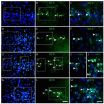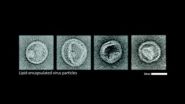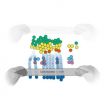(Press-News.org) Between 10 and 20 percent of all cases of epilepsy result from severe head injury, but a new drug promises to prevent post-traumatic seizures and may forestall further brain damage caused by seizures in those who already have epilepsy.
A team of researchers from the University of California, Berkeley, Ben-Gurion University in Israel and Charité-University Medicine in Germany reports in the current issue of the journal Annals of Neurology that a commonly used hypertension drug prevents a majority of cases of post-traumatic epilepsy in a rodent model of the disease. If independent experiments now underway in rats confirm this finding, human clinical trials could start within a few years.
"This is the first-ever approach in which epilepsy development is stopped, as opposed to common drugs that try to prevent seizures once epilepsy develops," said coauthor Daniela Kaufer, UC Berkeley associate professor of integrative biology and a member of the Helen Wills Neuroscience Institute. "Those drugs have a very limited success and many side effects, so we are excited about the new approach."
The team, led by Kaufer; neurosurgeon Alon Friedman, associate professor of physiology and neurobiology at the Ben-Gurion University of the Negev; and Uwe Heinemann of the Charite, provides the first explanation for how brain injury caused by a blow to the head, stroke or infection leads to epilepsy. Based on 10 years of collaborative research, their findings point a finger at the blood-brain barrier – the tight wall of cells lining the veins and arteries in the brain that is breached after trauma.
"This study for the first time offers a new mechanism and an existing, FDA-approved drug to potentially prevent epilepsy in patients after brain injuries or after they develop an abnormal blood-brain barrier," Friedman said.
The drug, losartan (Cozaar®), prevented seizures in 60 percent of the rats tested, when normally 100 percent of the rats develop seizures after injury. In the 40 percent of rats that did develop seizures, they averaged about one quarter the number of seizures typical for untreated rats. Another experiment showed that administration of losartan for three weeks at the time of injury was enough to prevent most cases of epilepsy in normal lab rats in the following months.
"This is a very exciting result, telling us that the drug worked to prevent the development of epilepsy and not by suppressing the symptoms," Kaufer said.
Breakdown of the blood-brain barrier
Kaufer and Friedman have been collaboratively investigating the effects of trauma on the brain since Kaufer was a graduate student in Israel 20 years ago. Throughout a postdoctoral position at Stanford University and after joining the UC Berkeley faculty in 2005, she maintained her interest in the blood-brain barrier, which normally protects the brain from potentially damaging chemicals or bacteria in the blood and prevents brain chemicals from leaking into the blood stream.
She and Friedman showed earlier that breaking down the barrier causes inflammation and leads to the development of epilepsy. They pinned the effect to a single protein called albumin, the most common protein in blood serum.
In 2009, they showed that albumin affects astrocytes, the brain's support cells, by binding to the TGF-β (transforming growth factor-beta) receptor. This initiates a cascade of steps that lead to localized inflammation, which appears to permanently damage the brain's wiring, leading to the electrical misfiring characteristic of epilepsy. The current paper conclusively demonstrates that blocking the TGF-beta receptor with losartan stops that cascade and prevents the disorder.
Drugs side effect proves crucial
Coauthor Guy Bar-Klein, a doctoral student at Ben-Gurion University, searched a long list of drugs before discovering losartan, which is approved to treat high blood pressure because it blocks the angiotensin receptor 1, but which incidentally also blocks TGF-β. It worked in the rats when delivered in their drinking water, which means that it somehow gets into the brain through the blood-brain barrier. The experiments suggest that the drug is unable to cross an intact blood-brain barrier, but reaches the brain through a breached barrier when it is most needed, Kaufer said.
Friedman developed a protocol to use MRI to check whether the blood brain barrier has been breached, allowing doctors to give losartan as a preventive treatment, if necessary, after trauma. Kaufer said that the barrier may remain open for only a few weeks after injury, so the drug would not have to be given very long to prevent damage.
"Right now, if someone comes to the emergency room with traumatic brain injury, they have a 10 to 50 percent chance of developing epilepsy, and epilepsy from brain injuries tends to be unresponsive to drugs in many patients." she said. "I'm very hopeful that our research can spare these patients the added trauma of epilepsy."
INFORMATION:
A portion of the research for this study was supported by the Bakar Fellows Program at UC Berkeley, which supports innovative research by early career faculty with a special focus on projects that hold commercial promise. Other funding came from the European Union's Seventh Framework Program, the Israel Science Foundation, the United States-Israel Binational Science Foundation and the National Institute of Neurological Disorders and Stroke of the National Institutes of Health (RO1/NINDS NS066005).
Other coauthors are Luisa P. Cacheaux, a former UC Berkeley graduate student who is now a postdoctoral scholar at the Center for Learning and Memory at the University of Texas, Austin; graduate students Lyn Kamintsky, Ofer Prager and Itai Weissberg of Ben-Gurion University; neuroscientists Uwe Heinemann and Karl Schoknecht of the Charité-Universitätsmedizin in Berlin, Germany; and graduate student Paul Cheng and postdocs Soo Young Kim and Lydia Wood of UC Berkeley's Helen Wills Neuroscience Institute.
Commonly available blood-pressure medication prevents epilepsy after severe brain injury
Drug could eliminate most seizures following serious head trauma
2014-04-22
ELSE PRESS RELEASES FROM THIS DATE:
Short-term environmental enrichment exposure induces maturity of newborn neurons
2014-04-22
Many studies have shown that exposure to environmental enrichment can induce neurogenesis of the hippocampal region, thus improving learning and memory. Previous studies have demonstrated that doublecortin-positive immature neurons exist predominantly in the superficial layer of the cerebral cortex of adult mammals such as guinea pigs, and these neurons exhibit very weak properties of self-proliferation during adulthood under physiological conditions. Whether environmental enrichment has an impact on the proliferation and maturation of these immature neurons in the prefrontal ...
Like a hall of mirrors, nanostructures trap photons inside ultrathin solar cells
2014-04-22
In the quest to make sun power more competitive, researchers are designing ultrathin solar cells that cut material costs. At the same time they're keeping these thin cells efficient by sculpting their surfaces with photovoltaic nanostructures that behave like a molecular hall of mirrors.
"We want to make sure light spends more quality time inside a solar cell," said Mark Brongersma, a professor of materials science and engineering at Stanford and co-author of a review article in Nature Materials.
Brongersma and two Stanford colleagues -- associate professor of materials ...
Grasp of SQUIDs dynamics facilitates eavesdropping
2014-04-22
Theoretical physicists are currently exploring the dynamics of a very unusual kind of device called a SQUID. This Superconducting Quantum Interference Device is a highly sensitive magnetometer used to measure extremely subtle magnetic fields. It is made of two thin regions of insulating material that separate two superconductors – referred to as Josephson junctions – placed in parallel into a ring of superconducting material. In a study published in EPJ B, US scientists have focused on finding an analytical approximation to the theoretical equations that govern the dynamics ...
Cloaked DNA nanodevices survive pilot mission
2014-04-22
VIDEO:
Wyss Institute Core Faculty member William Shih and Technology Development Fellow Steven Perrault explain why DNA nanodevices need protection inside the body and how a virus-inspired strategy helps protect them....
Click here for more information.
It's a familiar trope in science fiction: In enemy territory, activate your cloaking device. And real-world viruses use similar tactics to make themselves invisible to the immune system. Now scientists at Harvard's Wyss Institute ...
Carnegie Mellon system lets iPad users explore data with their fingers
2014-04-22
PITTSBURGH—Spreadsheets may have been the original killer app for personal computers, but data tables don't play to the strengths of multi-touch devices such as tablets. So researchers at Carnegie Mellon University have developed a visualization approach that allows people to explore complex data with their fingers.
Called Kinetica, this proof-of-concept system for the Apple iPad converts tabular data, such as Excel spreadsheets, so that data points appear as colored spheres on the touchscreen. People can directly manipulate this data, using natural gestures to sort, ...
Child's autism risk accelerates with mother's age over 30
2014-04-22
PHILADELPHIA (April 22, 2014) – Older parents are more likely to have a child who develops an autism spectrum disorder (ASD) than are younger parents. A recent study from researchers from the Drexel University School of Public Health in Philadelphia and Karolinska Institute in Sweden provides more insight into how the risk associated with parental age varies between mothers' and fathers' ages, and found that the risk of having a child with both ASD and intellectual disability is larger for older parents.
In the study, published in the February 2014 issue of the International ...
Nanomaterial outsmarts ions
2014-04-22
Ions are an essential tool in chip manufacturing, but these electrically charged atoms can also be used to produce nano-sieves with homogeneously distributed pores. A particularly large number of electrons, however, must be removed from the atoms for this purpose. Such highly charged ions either lose a surprisingly large amount of energy or almost no energy at all as they pass through a membrane that measures merely one nanometer in thickness. Researchers from the Helmholtz-Zentrum Dresden-Rossendorf (HZDR) and Vienna University of Technology (TU Wien) report in the scientific ...
Gym culture likened to McDonalds
2014-04-22
Visit a typical gym and you will encounter a highly standardised notion of what the human body should look like and how much it should weigh. This strictly controlled body ideal is spread across the world by large actors in the fitness industry.
A new study explores how the fitness industry in many ways resembles that of fast food. One of the authors is from the University of Gothenburg.
McDonaldisation of the gym culture is the theme of an article published in Sports, Education and Society, where Thomas Johansson, professor at the University of Gothenburg, together ...
Two genes linked to inflammatory bowel disease
2014-04-22
CINCINNATI—Inflammatory Bowel Disease (IBD), a group of chronic inflammatory disorders of the intestine that result in painful and debilitating complications, affects over 1.4 million people in the U.S., and while there are treatments to reduce inflammation for patients, there is no cure.
Now, Cincinnati Cancer Center and University of Cincinnati (UC) Cancer Institute researcher Susan Waltz, PhD, and scientists in her lab have done what is believed to be the first direct genetic study to document the important function for the Ron receptor, a cell surface protein often ...
New design for mobile phone masts could cut carbon emissions
2014-04-22
A breakthrough in the design of signal amplifiers for mobile phone masts could deliver a massive 200MW cut in the load on UK power stations, reducing CO2 emissions by around 0.5 million tonnes a year.
Funded by the Engineering and Physical Sciences Research Council (EPSRC), the Universities of Bristol and Cardiff have designed an amplifier that works at 50 per cent efficiency compared with the 30 per cent now typically achieved.
Currently, a 40W transmitter in a phone mast's base station* requires just over 130W of power to amplify signals and send them wirelessly ...
LAST 30 PRESS RELEASES:
DNA tests reveal mysterious beluga family trees
Strategic sex: Alaska’s beluga whales swap mates for long-term survival
How early cell membranes may have shaped the origins of life
Cannabis legalization is driving increases in marijuana use among U.S. adults with historically lower consumption rates
Multifunctional dipoles enabling enhanced ionic and electronic transport for high‑energy batteries
Triboelectric nanogenerators for future space missions
Advancing energy development with MBene: Chemical mechanism, AI, and applications in energy storage and harvesting
Heteroatom‑coordinated Fe–N4 catalysts for enhanced oxygen reduction in alkaline seawater zinc‑air batteries
Meta-device for precision lateral displacement sensing
Plasma-guided mitotane for the treatment of adrenocortical carcinoma: adjuvant care to advanced disease
Theoretical study of laser-enhanced nuclear fusion reactions
Social environment impacts sleep quality
Optimized kinetic pathways of active hydrogen generation at Cu2O/Cu heterojunction interfaces to enhance nitrate electroreduction to ammonia
New design playbook could unlock next generation high energy lithium ion batteries
Drones reveal how feral horse units keep boundaries
New AI tool removes bottleneck in animal movement analysis
Bubble netting knowledge spread by immigrant humpback whales
Discovery of bats remarkable navigation strategy revealed in new study
Urban tributaries identified as major sources of plastic chemical pollution in the Yangtze River
UK glaucoma cases higher than expected and projected to reach 1.6 million+ by 2060
Type 2 diabetes prevention could more than halve carbon footprint linked to disease complications
Over 1 million estimated to have glaucoma in UK
Early treatment can delay rheumatoid arthritis for years
National childhood type 1 diabetes screening is effective and could prevent thousands of emergency diagnoses, UK study shows
Mix of different types of physical activity may be best for longer life
Continuous care from community-based midwives reduces risk of preterm birth by 45%
Otago experts propose fiber as first new essential nutrient in 50 years
Auburn Physics PhD student earns prestigious DOE Fellowship
AI tool helps you learn how autistic communication works
To show LGBTQ+ support, look beyond Pride Month
[Press-News.org] Commonly available blood-pressure medication prevents epilepsy after severe brain injuryDrug could eliminate most seizures following serious head trauma






